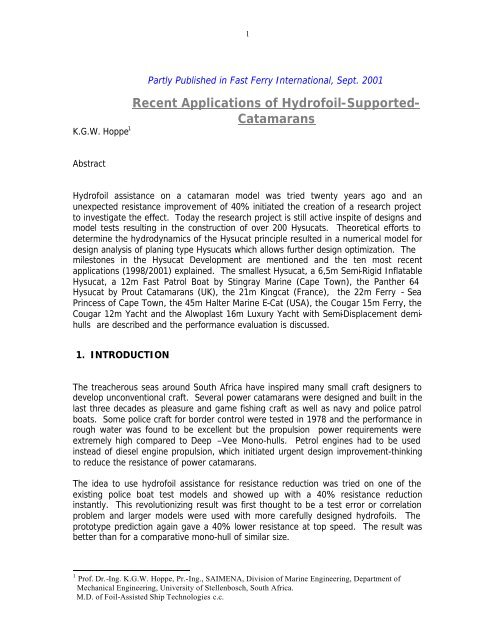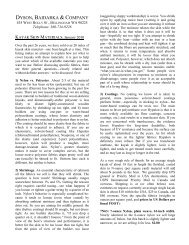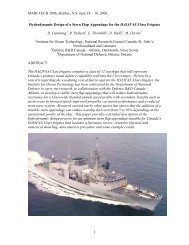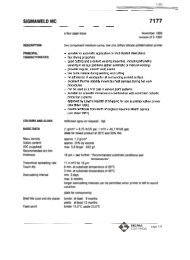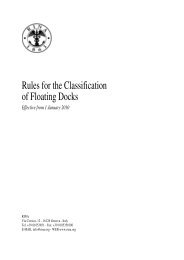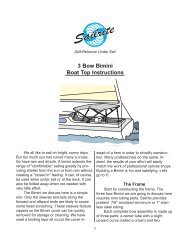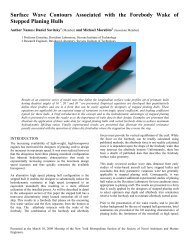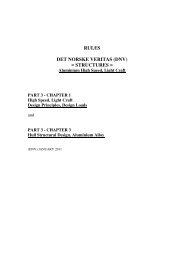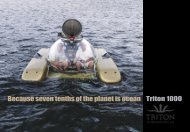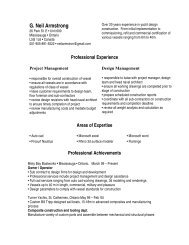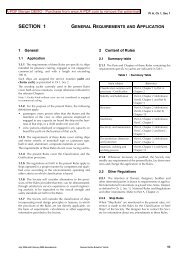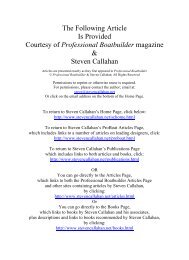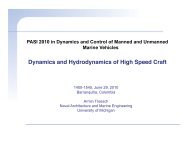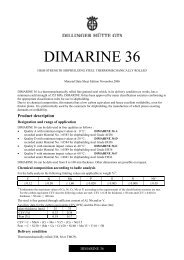Recent Applications of Hydrofoil-Supported- Catamarans - Boat ...
Recent Applications of Hydrofoil-Supported- Catamarans - Boat ...
Recent Applications of Hydrofoil-Supported- Catamarans - Boat ...
You also want an ePaper? Increase the reach of your titles
YUMPU automatically turns print PDFs into web optimized ePapers that Google loves.
Newsletterwww.tsbp.state.tx.us FALL 2012PRESIDENT’S COLUMNbyJeanne D. Waggener, R.Ph.Suggested Risk Reduction Strategiesfrom theInstitute for Safe Medication PracticesThe Institute for Safe Medication Practices (ISMP) is anindependent nonpr<strong>of</strong>it agency that analyzes medication errors,near misses, and potentially hazardous conditions as reportedby pharmacists and other practitioners. ISMP makes appropriatecontacts with companies and regulators, gathers expert opinionabout prevention measures, and publishes its recommendations.The following are suggestions from ISMP to reduce the risk <strong>of</strong>errors in the pharmacy.PATIENT INFORMATION• Ask for patient allergy information at every visit and validateagainst the patient pr<strong>of</strong>ile; distinguish between No KnownAllergies (NKA) and Unknown Allergies; confirm allergies atthe time <strong>of</strong> prescription pick up.• Routinely ask for patient diagnosis and co-morbid conditions,including pregnancy, and add this information to computerizedpatient pr<strong>of</strong>ile.• Be sure date-<strong>of</strong>-birth is noted on every prescription hardcopy and clearly visible on prescription receipt.• Obtain/validate patient weight when dispensing pediatricmedications.• Provide patient with updated medication list annually; confirmlist with patient.• Use two unique patient identifiers at point <strong>of</strong> sale.DRUG INFORMATION• Educate all staff, including technicians, about new drugproducts coming to market and/or being stocked in thepharmacy.• A designated pharmacist or corporate level staff routinelyreviews, for quality improvement purposes, reports <strong>of</strong>computer warnings that are overridden by pharmacists.• Review external error reports for potential risk within yourpharmacy.• Use the ISMP commonly confused drug list for examples <strong>of</strong>drug product names that could lead to error.• Routinely run reports <strong>of</strong> system speed codes in use andreview for dangerous short codes.• Speed codes should only be added by administrativepersonnel using standardized processes, not at store level.COMMUNICATION• Incorporate mandatory read back procedures when acceptingspoken prescription orders to confirm understanding.• Incorporate patient validation and second patient identifierwith prescriber or agent when accepting spoken prescriptionorders.• Repeat numbers in digits when receiving oral prescriptionorders (16 is stated “one-six”, 60 is stated “six-zero”).• Spell sound-alike drug names back to caller and obtainindication for use from caller for sound-alike medications.• Use prescription phone pads that prompt receiver to askcaller for allergies, date-<strong>of</strong>-birth, and indication for use orpurpose <strong>of</strong> drug.• Evaluate sig codes and speed codes for error potential.DRUG LABELING, PACKAGING, AND NOMENCLATURE• Provide auxiliary warning labels with exaggerated fonts, oruse other label enhancements on packages and storage bins<strong>of</strong> drugs with problematic names, packages, and labels.• Use shelf dividers to separate products with look-alikenames/packaging in all storage areas, including refrigeratorsand narcotic bins.• When dispensing unit-<strong>of</strong>-use packaging to patients, avoidplacing pharmacy label on top <strong>of</strong> pertinent manufacturer’sinformation.• Use labels with special precautions on the stock bottle <strong>of</strong>high-alert medication (those whose inadvertent dispensingcould cause serious harm if used in error).• Use FDA/ISMP-recommended tall man lettering onrepackaged products.• Implement tablet imaging on final verification screen.DRUG STANDARDIZATION, STORAGE, AND DISTRIBUTION• Institute a stocking program which completely separatesophthalmic and otic products that have been reported asbeing confused for one another.• Institute a “shelf-talker” or signing program that bringsattention to sound- or look-alike drug products duringstocking and retrieval procedures.• Eliminate from storage potentially dangerous chemicals nolonger necessary for compounding.• Do not store non-drug supplies, such as alcohol, neardiluents and products that require reconstitution.• Store in separate bins in the refrigerator different types <strong>of</strong>insulin products and other similar items.• Never stock any part <strong>of</strong> a product line <strong>of</strong> sound- or look-alikedrug in the “fast mover” section.{Abbreviated Information reproduced with permission fromISMP}InsideDisciplinary Actions ............................................................................................................................ p. 3Compliance Reminders ...................................................................................................................... p. 9Complaint Corner ............................................................................................................................... p. 10
2The hybrid consisting <strong>of</strong> a catamaran with fully asymmetrical demi-hulls and a singlehydr<strong>of</strong>oil spanning the tunnel between the two demi-hulls was named Hydr<strong>of</strong>oil<strong>Supported</strong> Catamaran or Hysucat in short. A research project was started to investigateand optimize the Hysucat principle (it is still running after 20 years!), see Hoppe (1980-1980a). A sea going 5.3m manned model was designed and built and proved theexcellent sea-keeping and low propulsion power needed for the craft. The craft wastested in various sea conditions from still water to extremely rough seas over a period <strong>of</strong>a year.More than 40 copies were sold as ski boats and pleasure craft the following two years.Designs for 10m and 12m police patrol boats and 18m Navy patrol boats followed, somefor overseas customers. The early designs were optimized in model tests but strongefforts were made to develop the theory behind the Hysucat principle, which resulted ina numerical model later based on the principle <strong>of</strong> the Savitsky (1976) formulations forplaning craft and basic hydr<strong>of</strong>oil design as developed for hydr<strong>of</strong>oil craft, Lewis (1998).Equilibrium <strong>of</strong> floatation to weight and longitudinal moments is established by thecomputer program. With empirical data inputs from model tests and prototype trial datathe numerical model was continuously updated and perfected to date. It allowsaccurate predictions for the standard Hysucat shape with asymmetrical demi-hulls andDeep-Vee craft characteristics and good approaches for the different hull forms.Catamaran models were first tested and optimized without foils and then retested andoptimized with various foil systems.It was found that a catamaran with a mono-foil was extremely sensitive to LongitudinalCenter <strong>of</strong> Gravity (LCG) shifts and an active trim device was necessary for practicaloperations.To overcome this shortcoming the Hysucat idea was extended by use <strong>of</strong> a double foilsystem. The main foil located slightly forward <strong>of</strong> the LCG <strong>of</strong> the craft and one trim foilor two trim strut foils near the transom as shown below in Figure 1. See Hoppe(1982,1989).Hysucat Foil SystemHysuwac Foil SystemFigure 1: Hysucat and Hysuwac Foil Systems
3Making use <strong>of</strong> the so-called hydr<strong>of</strong>oil free surface effect the Hysucat has a built-inautomatic trim-stabilizing characteristic, which allows for larger LCG shifts. The designallows a stable craft with a fixed wing foil system in the full speed range. Propulsionpower is down by 35% to 40% compared with similar Deep-Vee mono-hulls. SeeHoppe (1991,1991a, 1992 and 1995). Many craft were built after this principle rangingin size from 4.5m to 36m.The early hydr<strong>of</strong>oils were designed by use <strong>of</strong> NACA airfoil sections. However, it wasfound that the production <strong>of</strong> these foils for the larger craft was too expensivenecessitating numerical controlled cutting processes. Foil shapes were thereforedeveloped which allow cheaper production by use <strong>of</strong> rolled plate sections in weldedarrangements. High tensile steel <strong>of</strong> SAF 2205 or similar had to be used for the fasterHysucats , as the foils have to be very thin to prevent cavitation. Foil loads at top speedin wave passages are extremely high and can exceed the total weight force <strong>of</strong> the craft.Extensive strength calculations including Finite Element Analysis are design requisites forthe larger Hysucats.The Hysucat hydr<strong>of</strong>oil pr<strong>of</strong>ile sections have extended circular arc surfaces. Systematictowing tank tests were conducted with variation <strong>of</strong> the aspect ratio, angle <strong>of</strong> attack,depth <strong>of</strong> immersion and speed as little data on foil tests in extreme free surface effectare published. A second pr<strong>of</strong>ile section shape with a concave lower surface was alsotested and gave higher efficiencies in close surface approach. It is the preferred pr<strong>of</strong>ilesection for very fast Hysucats now.Most <strong>of</strong> the catamaran demi-hulls in the Hysucat project are <strong>of</strong> the fully asymmetricaldemi-hull type with a straight walled tunnel which allows for reduced hull interferenceand which gives the ideal flow conditions for efficient hydr<strong>of</strong>oil operation. The type <strong>of</strong>demi-hull has been proven to give the most sea friendly high-speed behavior. However,many Hysucats now on the sea, are existing catamarans for which a hydr<strong>of</strong>oil systemwas retr<strong>of</strong>itted afterwards. These so-called Hysucat conversions are more difficult tooptimize and have somewhat lower efficiencies.The Cape Town Company “T-Craft Marine” built a large number <strong>of</strong> 10m, 12m, 20m and22m Hysucat conversions. The hulls have been designed by “Bob van Niekerk,” wellknown fast craft designer in South Africa. These craft have shown that the Hysucatprinciple delivers practical high speed rough water work boats. The company closeddown in 1992 but some <strong>of</strong> their designs are still built with improved hull shape and foildesigns, by Stingray Marine and Waterfront Charters in Cape Town.
42. RECENT HYSUCAT APPLICATIONS (1998/01)Stingray Marine developed a 12m fast Interceptor as a Navy Patrol <strong>Boat</strong>. The fully ladencraft weighs 13.5t and is propelled by twin Caterpillar diesel engines with 2 x 320kW.The propulsion is by twin Arneson surface drive systems with Teignbridge (U.K.) surfacepropellers. The contract speed was 35 knots, the prototype reached 42 knots fully ladenin sea trials <strong>of</strong>f Cape Town. Three units have been delivered in 1998 to a foreign Navy.The Interceptor has a so-called Avion Hydr<strong>of</strong>oil system designed by Pr<strong>of</strong>. K.G. Hoppe atthe University <strong>of</strong> Stellenbosch and contracted by Unistel Technologies, the University’stechnology transfer company. (See Hysucat Web page: www.unistel.com).The following Hysucat application in 1998, which was completed with successful trials inEngland, is the conversion <strong>of</strong> the well-known Panther 64 by Prout <strong>Catamarans</strong> Ltd inthe U.K.. The Panther 64 is a luxury yacht <strong>of</strong> nearly 20m with 35t displacement. It hasfully asymmetrical demi-hulls similar to deep Vee planing hulls for good rough waterperformance. The straight tunnel between the hulls with nearly vertical sidewalls <strong>of</strong>fersvery favourable flow conditions for a hydr<strong>of</strong>oil system. The overall beam is 6.7m with atunnel width <strong>of</strong> 2.85m allowing a main foil with reasonable aspect ratio to be fitted.The Panther 64 is propelled by twin 850kW MTU diesel engines driving two Parkerwaterjets built by Vosper Thornycraft, so called Vos-jets. The waterjets allow trimadjustments <strong>of</strong> the craft at speed by means <strong>of</strong> adjustable exit nozzles, which makesthese jets especially useful in a Hysucat application.Figure 2: The Prout Panther 64
5The avion type Hysucat foil system used, was developed by Pr<strong>of</strong>. K.G. Hoppe at theUniversity <strong>of</strong> Stellenbosch and contracted through Unistel Technologies, the UniversitiesTechnology Transfer company. The foil system was optimized by use <strong>of</strong> the numericalmodel, which had been validated in many previous applications, by use <strong>of</strong> physicalmodels and prototype sea-trial back feed data.It was therefore not necessary to perform tank testing on the Panther hull although it isusually strongly recommended. The main foil was built <strong>of</strong> high tensile stainless steel byMaitland Metal Fabricators, Cape Town. The stern foils were cast in aluminium bronzeand accurately machined and ground to a high quality surface finish. The foils wereshipped to the UK where they were installed on the Panther 64 after initial sea trialswithout the foils. This way the improvement due to the foil system could be determinedaccurately.It was a welcome procedure for the designer who had encountered strong disbelief inhis 40% performance improvement prediction. Without foils, the Panther 64 reached29 to 30 knots (occasionally) with a displacement <strong>of</strong> 32.5t in the initial sea trials over themeasured mile on the Thames estuary. A week later with foils fitted the Panther 64showed up with a top speed <strong>of</strong> 44 knots over the same mile and weight but includingthe foils (33.5t). Fully tanked and equipped it ran 42 knots with 35t.The average improvement in top speed, therefore, was in excess <strong>of</strong> 40%. No otherchanges had been made to the craft. Certain further speed improvements are stillfeasible when the underwater fittings such as water intakes and exits and echo sounderinstallation are adapted to the new top speed and are further streamlined. The generalhull finish can be further improved by use <strong>of</strong> smooth anti-fouling paints.In a previous publication in FAST FERRY International, see Hoppe (1991), aperformance comparison method <strong>of</strong> ships was developed which resulted in the so calledpower ratioe p = p b /? [t] * 9.8 * V [knot] * 0,5144which gives a dimensionally clean physical performance comparison. It was found thatthe e p = 1 / ? Twith ? Tbeing the well known transport efficiency.The smaller the e p value <strong>of</strong> a craft build-up with the top performance data the moreefficient is the craft. Usually the e p increases for ships operating at larger FroudeDisplacement NumbersFnD = V / ? g * ? 0.333.The diagram Figure 4 <strong>of</strong> Hoppe (1991) gives many different craft e p values aside <strong>of</strong>tendency curves over Froude number. It can be used for direct comparisons <strong>of</strong> a designproposal with successful craft.The power ratio e p <strong>of</strong> the Prout Panther without foils is e p = 0,346 at FnD = 2,76.
6With the foil system installed is e p = 0,229 at FnD = 3,82, which means animprovement <strong>of</strong> 33,8% in performance and a 26,8% speed improvement.A tandem Hysucat hydr<strong>of</strong>oil system was developed for the 22m Ferry “Sea Princess”for Waterfront Charters in Cape Town, RSA. The hulls were designed by “Bob vanNiekerk” for the former company T-Craft. Model tests were conducted in the towingtank at the University <strong>of</strong> Stellenbosch with various foil systems. The tandem foil systemgave the best result at the top speed <strong>of</strong> 34 knots and in the middle speed range around25 knots which is mainly used for sightseeing operations and allows most economicalcruising.The craft weighs fully laden (120 Passengers) nearly 60t and reached a top speed <strong>of</strong> 32knots. However, the propellers only absorbed 80% <strong>of</strong> the MTU Diesel engines <strong>of</strong>1000kW in the initial seatrials and the power ratio is e p = 0,19 at the Froude NumberFnD = 2,50 and a slenderness ratio L /? 0.33 = 5,27, (? being the volumetricdisplacement) making the Sea Princess a very efficient hull.The photograph <strong>of</strong> Figure 3. shows the Sea Princess during sightseeing trips around theCape Peninsula <strong>of</strong>f Cape Town harbour.Figure 3: The Sea Princess
7A hydrodynamic stabilizer system was developed for the 21m Yacht “Kingcat” built byKingcat SA Shipyard in France on the basis <strong>of</strong> the Hysucat principle. The Kingcat hassymmetrical planing demi-hulls <strong>of</strong> the wave piercing type with moderate deep-V andextremely fine bows for reduced pitching in rough water. The hydr<strong>of</strong>oil system consists<strong>of</strong> a mainfoil slightly forward the LCG position and a full beam sternfoil with attack anglecontrol spanning the tunnel width near the transom.With extensive mechanisation and computer control <strong>of</strong> all essential functions <strong>of</strong> the shipit weighs about 72t and therefore has a very low slenderness ratio L /? 0.33 = 5,13(heavily loaded hull !).It was found in the Kingcat model tests at the University <strong>of</strong> Stellenbosch, RSA, that thetandem foil system gives considerably improved resistance in the medium speed rangecompared to the Hysucat foil system with two rear struts, especially if the rear foil attackangle can be adjusted for optimised resistance at the hump resistance speed. Thehelmsman has total control over the trim angle at speed and can choose the best trimfor the top speed. The four MAN D2842 Diesel engines <strong>of</strong> 4 x 880kW driving 4 Lipswaterjets L J 43DL give the Kingcat a topspeed <strong>of</strong> 46 knots and fully laden 44 knots.It was a design condition that the frontfoil was not to be connected to the hulls belowthe waterline and the lift at speed is transmitted by two vertical struts fixed to thetunnel ceiling. The rearfoil is fixed on two shaft struts carried by the flange. The shaftstruts do not penetrate the hulls and even in a collision damage the watertight integrity<strong>of</strong> the ship is not affected. Figure 4. shows the Kingcat in the initial trial runs <strong>of</strong>f SableD’Olonne on the French Atlantic coast.Figure 4: The Kingcat
8The power ratio e p <strong>of</strong> the Kingcat made up with the trial data is e p = 0,21, calculatedwith full power absorption at a Froude Displacement Number <strong>of</strong> FnD = 3,52 which canbe entered in the Graph <strong>of</strong> Figure 4, <strong>of</strong> the report Hoppe (1991).It shows that the Kingcat Hysucat has a 34% improved total hydrodynamic efficiencyagainst a Deep-V-monohull. However, this result could be better as it was observedduring sea trials that the full engine power <strong>of</strong> the MAN engines was not absorbed andan 18% power reserve remained.Increasing requests for foil assistance for the larger high speed ferries initiated aresearch and development project about four years ago. Several semi-displacementcatamaran hulls were developed at the Mechanical Engineering Department <strong>of</strong> theUniversity <strong>of</strong> Stellenbosch and tested in several model test series with various foilsystems.At first it looked as if these large catamarans could not be improved with a standardhydr<strong>of</strong>oil system and only at very high Froude numbers improvements were recorded.The standard high speed semi-displacement catamaran operates most efficient at aFroude number <strong>of</strong> 2,1 to 2,3 and below the corresponding speeds the foil system givesno improvement and sometimes even a resistance increase. For higher Froude numbersconsiderable improvements were possible, but the ships in operation usually had notsufficient power reserves to reach the necessary high speeds for Froude numbers above2,1 or 2,3.It was necessary to develop a foil system which could already improve at the lowerspeeds and especially at the hump-resistance speed. The model <strong>of</strong> a 72m car ferry wastested with 8 different foil systems and an improvement over most <strong>of</strong> the speed range,including Froude numbers <strong>of</strong> 2,1 was only possible with a tandem foil assist systemconsisting <strong>of</strong> a high aspect ratio forward foil, positioned relatively far forward <strong>of</strong> the LCGposition and a full-tunnel-width rear foil connecting both demi-hulls near to thetransoms, see Fig. 1. The foil system was arranged to minimize the foil interferencebetween forward and rear foil and the interference between each foil and the demihulls.The hybrid with this foil system was named Hydr<strong>of</strong>oil-Assisted-Watercraft (Hysuwac) asit is applicable in principle also to fast mono-hulls and tri-marans. The subsequentmodel tests showed that resistance improvements on semi-displacement catamarans inthe higher speed range <strong>of</strong> over 40% are possible without severe penalties in the lowerspeed range. The seakeeping quality and rough water performance are also improvedwith a considerable damping effect at speed. The model tests also indicated that thewake wash <strong>of</strong> these foil supported models was observed to be considerably lower thanon the models without foils and on those models which had a standard Hysucat foilsystem.With the experience gained in the Hysuwac development project a foil system wasdeveloped for the Halter Marine E-Cat which is a 45m high speed semi-diplacementcatamaran developed for low wash operation. The E-Cat has very fine bows and a highslenderness degree ( L /? ? = 7,5) with a beam-draught ratio <strong>of</strong> nearly unity. The wide
9tunnel between the demi-hulls gives an ideal situation for a high aspect ratio foil systemallowing a forward foil spanning nearly 11m.After initial calculations a design including a model test was proposed. Halter Marineresponded with stating that they had already a model. The question about the model’ssize was answered with “45m overall length” and meant the 45m E-Cat demonstrator inNew Orleans, USA.The challenge was taken up and a design without model tests was produced and the foilsystem was built by the Halter Marine Shipyard in New Orleans. Seatrials were run inSeptember and October 1999 and proved the predicted enormous resistance reductionwith the E-Cat at 175t load displacement reaching 42 to 44 knots top speed and 46knots at a lighter load. Propulsion is by twin Caterpillar Diesel engines 3516B <strong>of</strong> 2 x1910kW and twin MJP / Bird-Johnson 650 waterjets, see Halter Marine (2000).The E-Cat power ratio with these trial results give a power ratio for the craft withoutfoils <strong>of</strong>e p = 0,140 at FnD = 2,16 ? T= 7,14and with a Hysuwac foil system installede p = 0,103 at FnD = 2,92 ? T= 9,71.This presents the lowest power ratio or highest transport efficiency <strong>of</strong> any comparableferry type hull found in literature and used for the Hysucat data base. It also indicatesthat massive improvement on fast ferries with Semi-Displacement hulls are feasible.Wake tests conducted by Mr. Stumbo <strong>of</strong> Washington State Ferries (WSF) confirmed thelow wash <strong>of</strong> the foil assisted E-Cat observed in earlier model tests on similar hulls, seeStumbo S. (2000).Mr. Stumbo stated that the E-Cat had the lowest wash <strong>of</strong> all the ferries tested in hisprogram, but that the water depth in the lake was relatively low and that shallow watereffects could not be eliminated completely and that a CFD-study will have to clear thesituation and the influence <strong>of</strong> the water depth. Most other wake tests were conductedin deeper water. Usually the wave wake wash is amplified in shallow water.The photograph in Figure 5 shows the foil assisted E-Cat at speed in the seatrials. Thehulls are now running much higher out <strong>of</strong> the water and therefore it will be necessary toextend the Tigres picture along the side hulls well below the waterline.
10Figure 5: The E-Cat with foils at 42 knotsFigure 6. shows the E-Cat mainfoil at a speed <strong>of</strong> 44 knots during the trial runs. Asomewhat new flow phenomenon was observed which can not be classified as cavitationbut rather as low pressure ventilation, see the “white water flow” over the foil whichmoved forward with increasing speeds. At lighter loads the E-Cat achieved up to 46knots and the ventilation effect appeared even stronger, however, no cavitation erosionor performance reduction were observed even through the speed was far above thedesign speed <strong>of</strong> 40knots and the foil-tip pr<strong>of</strong>ile thickness – chord – ratio too high forcavitation free operation.It is believed that the foil in close surface effect mode is not prone to cavitation asexpected. This means that much higher speeds will be possible when operating the foilsin close surface effect mode. Further research is necessary to clarify this newphenomenon.
11Figure 6: The E-Cat foil at speedAt the beginning <strong>of</strong> the year 2000 a Hysucat hydr<strong>of</strong>oil system was developed for the14.6m high speed catamaran “Wildcat” (Cougar 15) built by Cougar <strong>Catamarans</strong>,Australia. This open deck ferry for 54 passengers and 2 crew members is used fortourist transport and so called joy-rides in waves <strong>of</strong>f the shores <strong>of</strong> Bermuda Island.The catamaran has a beam <strong>of</strong> 5,2m and a maximum operational full load displacement<strong>of</strong> 22 t. A new aspect in this hull concerning the foil design is the semetrical demi-hullshape with a high deadrise angle <strong>of</strong> over 40° and nearly prismatic shape <strong>of</strong> most <strong>of</strong> thelength <strong>of</strong> the hull. It meant that a three-dimensional mainfoil had to be designed whichhad to be fitted to the planing bottom somewhere between the keel and the chine.Otherwise a standard Hysucat foil system with the mainfoil slightly forward <strong>of</strong> the LCGposition and two rearfoil struts near the transom was adapted. The “Wildcat” ispowered by twin Caterpillar 340GE Diesel engines rated at 588 kW and seafury SF30surface drives.The initial trial runs were first completed with the “Wildcat” without foils and achieved atopspeed <strong>of</strong> 40 knots at a displacement o 20,7 t. Due to high propeller pitch the enginerpm’s were 500rpm down.
12This corresponds to a power ratio e p <strong>of</strong>e p = 0.282 at FnD = 3,97which indicates a good performance for a standard catamaran.A few days later with the Hysucat foil system installed and with the maximum total load<strong>of</strong> 22 t, simulated with sandbags, the “Wildcat” reached 49 knots with the engine rpm’sstill down by 365 rpm. The propellers apparently had still a too high pitch or diameterand the predicted speed <strong>of</strong> 52 knots could still become reality with further fine tuning.The Cougar-Hysucat 15 under these conditions gives a power ratio <strong>of</strong>e p = 0,216 at FnD = 4,81which means an efficiency improvement <strong>of</strong> 23,4%. Once the propulsion system isoptimally adapted to the new speed conditions further improvements have to beexpected.The “Wildcat” ran the Bermuda Challenge race in July 2000 but had to withdraw 60miles out <strong>of</strong> Bermuda due to one engine failure. Up to this point it had broken thestanding record easily. The photograph in Fig. 7 shows the “Wildcat” with foils at about44 knots during the trial runs.Figure 7: “Wildcat”
13Another foil system was developed in parallel for the Cougar Catamaran 13,2m witha relatively lower propulsion power for the weight concerned <strong>of</strong> twin 320 kW Dieselengines with Seafury SF26 surface drives. The Cougar 13 has a waterline length <strong>of</strong>10,700m and an overall length <strong>of</strong> 13,2m and a beam <strong>of</strong> 4,20m. The design weight wasestimated to be 12,5 t. The demi-hulls are also <strong>of</strong> the symmetrical type with highdeadrise and prismatic shape over most <strong>of</strong> the hull length .However, the final maximum weight in the trial runs ended up with 16 t which reducedthe prospects <strong>of</strong> achieving the predicted topspeed <strong>of</strong> 42 knots.In the initial trials in June 2001 the Cougar Hysucat 13,2m reached a topspeed <strong>of</strong> 38knots with 16 t displacement and 40 knots at a lighter load (about 2 tons less).This craft has a Hysucat tandem foil system (full tunnel-width-rearfoil) which reacheshigher efficiencies in the midspeed range. The rearfoil was designed to be easily readjustablein attack angle by a shift <strong>of</strong> one bolt. The power ratio e p under theseconditions with considerably increased displacement weight ise p = 0,209 at a Froude Number <strong>of</strong> FnD = 3,940which is close to the predicted result. The propulsive coefficient P.C. = Pe / Pb resultsin a P.C. = ? t / e p = 0,115 / 0,209 = 0,55 wherein ? t is taken from designcalculation data, which seems low for a surface propeller system.In the design the topspeed <strong>of</strong> the catamaran without foils was estimated to be 32,7knots with a displacement <strong>of</strong>? = 12,5 t, which means a power ratioe p = 0,311 at FnD = 3,529which is a good expected result for a catamaran after tendency curves.The foil system improved the power ratio or the transport efficiency by 32,8%. Speedwas increased by 15% with a weight increase <strong>of</strong> 28%.In the trial runs the full engine rpm’s were not reached but were down 400rpm. Withproper tuning <strong>of</strong> the propulsion system to prevailing hull and foil conditions considerableimprovements are still feasible. However, the boat was delivered this way. Slightporpoising tendencies could be corrected by a slightly higher sternfoil angle (increase +1degree!).In summary it can be stated that both Cougar <strong>Catamarans</strong> were considerably improvedby the foil systems with higher topspeeds and improved fuel efficiency. There is noother way than by a foil system to achieve such significant improvements.
14Towards the end <strong>of</strong> the year 2000 a feasibility study by FASTcc for a foil design for the16m catamaran “Molly” with symmetrical Semi-Displacement demi-hulls wasconducted for the shipyard ALWOPLAST Ltda in Valdivia in Chile. The ship, called“Molly” had been built after the design <strong>of</strong> Brett Crowther, Australia and achieved a topspeed <strong>of</strong> 22 knots with a full load displacement <strong>of</strong> 22 t and two Yanmar 8CX-ETE Dieselengines developing 313 kW each.The hydrodynamics <strong>of</strong> a Hysucat and a Hysuwac foil system were calculated by use <strong>of</strong>Pr<strong>of</strong> K.G. Hoppe’s Hysucat computer model and gave the resistance and thrust curvesshown in Figure 8. Together with the Hamilton waterjet characteristic <strong>of</strong> the HJ 321 Jet.It indicates that the Hysuwac foil system is more efficient in the speed range 15 to 35knots than the Hysucat foil system, with about 16% improvement at 25 knots. Afterthese calculations the catamaran without foils should reach a top speed <strong>of</strong> nearly 26knots. This was also the Crowther prediction.
15However, the trials in Chile only gave a top speed <strong>of</strong> 22 knots. The deficiency waspartly traced down to come from additional drag <strong>of</strong> four large transom skegs fordirectional stability.The owners decided to choose the Hysucat foil system in spite <strong>of</strong> the higher resistancevis-à-vis the Hysuwac foil system because <strong>of</strong> shallow water conditions which did notallow the front foil <strong>of</strong> the Hysuwac to penetrate about 400mm below the keel line.With some correction on the skegs a top speed <strong>of</strong> 32,5 knots for the Hysucat waspredicted and a contract <strong>of</strong> Unistel Technologies (Pty) Ltd, the Stellenbosch University’sTechnology Transfer Company accepted for the Design and Technology package. Thedesign was subcontracted to FASTcc and the foil system built by Hydr<strong>of</strong>oil Manufacturers(Pty) Ltd in Gordon’s Bay who subcontracted to Hydrospeed (Pty) Ltd <strong>of</strong> Cape Town.The foils were installed in February 2001 and the following initial trials gave top speedreadings <strong>of</strong> 32 to 34 knots in relatively calm water after the report by Mr. Wopper <strong>of</strong>Alwoplast. In rough sea conditions (“confused sea”) the 18 knots at 2700rpm for thecatamaran became 22 knots at 2500rpm for the Hysucat.The faster ship showed some bow steering in strong winds and steering with too largejet rudder settings became necessary which indicated that the skegs were still too largeand counteracted the jet steering effect.Alwoplast is replacing the skegs at the moment with two steerable spate rudder-skegs inorder to steer the ship in future at speed by rudder and not by waterjets as the use <strong>of</strong>excessive waterjet nozzle steering leads to a thrust loss which can exceed 20% andwhich reduces the top speed immediately and which leads to increased fuelconsumption. Improved performance is expected soon.So far it can be said hat the Hysucat foil system has improved the ship considerably.The power ratio (transport efficiency!) e p without foil was determined on the base <strong>of</strong>the original trial results and wasNo foils: e p = 0,257 at a Froude Number FnD = 2,16With foils: e p = 0,166 at a Froude Number FnD 3,34which indicates an improvement <strong>of</strong> 35,4% in performance. In the situation for whichthe Hysucat top speed was only 32 knots the improvement is still 31,5%.So far, the “Molly” is the first Semi-Displacement catamaran with a Hysucat foil system.The foil system is complicated by the hull shape with round bilge to which the foilflanges have to be carefully adapted. The rearfoil is adjustable in attack angle by use <strong>of</strong>an oil-hydraulic actuator driven by the inboard high oil pressure supply <strong>of</strong> the waterjetsystem.
16It is reported that the trim can be fast and easily adjusted to the helmsman’s wishes andthe running attitude <strong>of</strong> the boat be adapted to the prevailing sea conditions in the bestway. The photograph in Fig. 9 shows the Molly with foils at about 30 knots during theinitial trials.Figure 9 : Molly with foils during the initial trial runs
173. CONCLUSIONThe hybrid <strong>of</strong> a catamaran hull in combination with lifting hydr<strong>of</strong>oils improves the hullefficiency considerably and this has now been proven in many applications. The liftcarrying capability <strong>of</strong> hydr<strong>of</strong>oils when designed for optimum condition is so much betterthan the one <strong>of</strong> the standard fast ship hulls that still further improvements seemfeasible.However, not only the resistance improvement alone is important but all otherperformance parameters <strong>of</strong> a craft as the dynamic trim, course-holding, transverse andlongitudinal stability at all speeds, broaching and porposing behaviour, seakeeping etc.must not be negatively <strong>of</strong>f-set by the addition <strong>of</strong> a foil system. This makes the design <strong>of</strong>a Hysucat a formidable and sophisticated task which very few designers are able totackle without extensive use <strong>of</strong> model- or prototype testing.The progress in the Hysucat development is therefore very slow. The use <strong>of</strong> supportinghydr<strong>of</strong>oils for catamarans was first thought to be <strong>of</strong> advantage for the smaller craft onlyand 20m long craft were thought to present the optimum. However, on request largercraft were investigated and new foil systems developed which were optimal for the newconditions and also considerable improvements were achieved. The largest foil systemdesigned to date and under construction is for a 72m car ferry weighing 630t.The gaul in this project <strong>of</strong> a Diesel driven ferry is a speed increase from todays 48 to 50knot to nearly 60 knots with foil-support. The advantages <strong>of</strong> foil assistance do not endhere and the application to the fast and larger gas turbine powered ferries might proveeven more fruitful with reduced resistance and propulsion power per weight unit,reduced consumption and emmision.Such new designs are not easily reached by simple conversions <strong>of</strong> existing ferries t<strong>of</strong>oil-assisted catamarans but have to be designed from the beginning on as anintergrated entiety including the propulsion system. The author has the strong beliefthat considerable design improvements will follow in the near future. So far all Hysucatand Hysuwac foil systems have been designed by Foil-Assisted-Ship-Technologies c.c.(FASTcc). For further information please visit the Webpage <strong>of</strong> FASTcc,www.FASTcc.co.zaFor further questions please contact Pr<strong>of</strong>. Karl Gunter Hoppe at FASTcc on:Tel: +27 21 8552116 / 8555478Fax: +27 21 8555477email: fastcc@hydr<strong>of</strong>oildesign.comwebsite: www.hydr<strong>of</strong>oildesign.com
184. REFERENCESSavitsky D.(1976) “Hydrodynamic Design <strong>of</strong> Planing Hulls,” Marine Technology Vol.1.Hoppe, K-G. (1980), “<strong>Boat</strong>s, Hydr<strong>of</strong>oil Assisted Catamaran,” SA Patent 80/5400 andcorresponding foreign patents.Hoppe, K-G. (1980a), “The Hydr<strong>of</strong>oil <strong>Supported</strong> Catamaran,” Internal Report 1980-2, Mech,Eng., Unv. Of Stellenbosch.Hoppe, K-G. (1982), “<strong>Boat</strong>s, Hydr<strong>of</strong>oil <strong>Supported</strong> Catamaran,” SA Patent 82/3505 andcorresponding foreign patents.Hoppe, K-G. (1989), “The Hysucat Development,” Internal Report 1989, Mech, Eng., Dept.,University <strong>of</strong> Stellenbosch, RSA.Hoppe K-G. (1991), “Performance Evaluation <strong>of</strong> High Speed Surface Craft with Reference tothe Hysucat Development,” Fast Ferry International, Vol. 30 No.1 and 3, January and April 1991.Hoppe, K-G. (1991a), “The Hysucat Development,” Ship Technology Research. Vol. 38, 1991.Hoppe, K-G. (1992), “Hysucat – an all South African Development, The Hysucat Development,”SA Mechanical Engineer, Vol. 42, No. 10, October.Hoppe, K-G. (1995), “Optimization <strong>of</strong> Hydr<strong>of</strong>oil <strong>Supported</strong> Planing <strong>Catamarans</strong>,” FAST’95,Third International Conference on Fast Sea Transportation, Vol.1.Hoppe, K-G.1996, pp 18.(1996), “Hydr<strong>of</strong>oil <strong>Supported</strong> <strong>Catamarans</strong>, Hysucats,” Work <strong>Boat</strong> World, October,Hoppe, K-G. (1997), “Hydr<strong>of</strong>oil System increases the speed <strong>of</strong> <strong>Catamarans</strong> ,” Work <strong>Boat</strong>World, No. 16(1), pp 27.Migeotte G. (1997), “Development <strong>of</strong> Hydr<strong>of</strong>oil <strong>Supported</strong> <strong>Catamarans</strong> with Semi-DisplacementHulls,” University <strong>of</strong> Stellenbosch, Department <strong>of</strong> Mechanical Engineering, M.Eng. Thesis.Hoppe, K-G.(1998), SA Patent Application 98/3763 and overseas applications.Lewis E.V. Ed. (1998) Principles <strong>of</strong> Naval Architecture, Second Revision, Society <strong>of</strong> NavalArchitects and Marine Engineers.Hoppe, K-G. (1999), “Hydr<strong>of</strong>oil Catamaran Development in South Africa” HIPER’99 InternationalConference at Zevenwacht, South Africa, 17-19 March 1999.Migeotte G., Hoppe K-G. (1999), “Development <strong>of</strong> Hydr<strong>of</strong>oil Assisted <strong>Catamarans</strong> with Semi-Displacement Hulls,” HIPER’99, International Conference on High-Performance Marine Vehicles,Zevenwacht, South Africa, 17-19 March 1999.Migoette G., Hoppe K-G. (1999), “Development in Hydr<strong>of</strong>oil Assistance for Semi-Displacement<strong>Catamarans</strong>”, FAST’99, Seattle, USA, September 1999.Godfrey Castle (2000), “Stealth 6,5m Hysucat,” Leisure <strong>Boat</strong>ing, Caravan Publications (Pty) Ltd.,Cape Town, April 2000.
19Stumbo S. (2000), Wake Measurement Trials – E-Cat with Foil Assist, Report by WashingtonFerries, Vessel Design, January 2000.Halter Marine (2000), Halter Marine installs foils on E-Cat catamaran, Fast Ferry International,January – February 2000.Kornew, N.; Migeotte G.; Hoppe K.G.; Nesterova A., (2001), Design <strong>of</strong> Hydr<strong>of</strong>oil Assisted<strong>Catamarans</strong> using a Non-Linear Vortex Lattice Method, HIPER” 01, Hamberg, 2-5 May 2001


